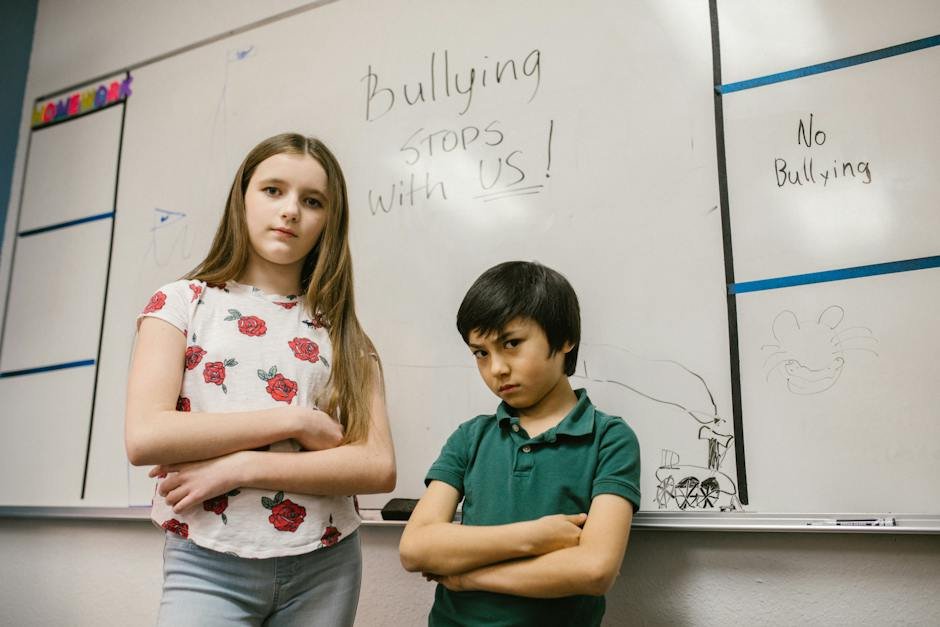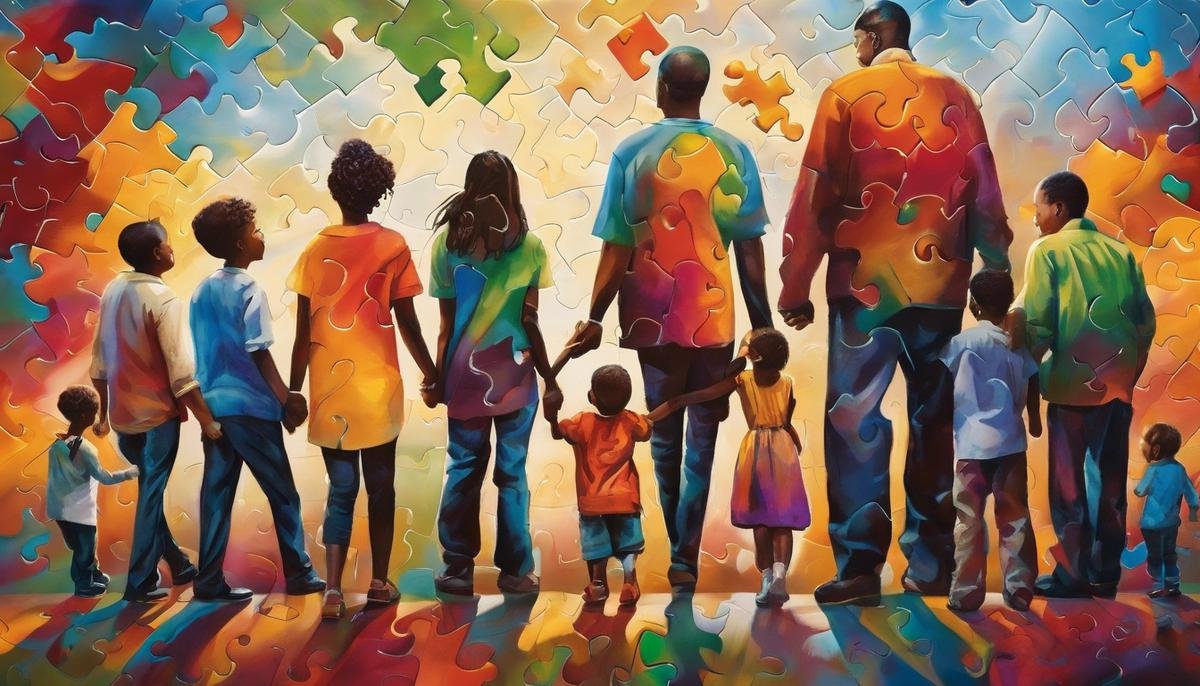
Families navigating the complexities of autism spectrum disorder face unique challenges, often hidden from the public eye. Among these is the manifestation of aggression—a symptom that can arise from the whirlpool of sensory overstimulation, hums of communication barriers, and currents of frustration commonly experienced by children with autism. Understanding these undercurrents is vital for providing the proper support. This discussion aims to shed light on the multifaceted nature of autism-related aggression, offering insights into its triggers, and equipping families with strategies to create a nurturing environment for growth and healing. In a journey that demands patience and resilience, knowledge becomes a beacon, guiding parents and siblings through stormy seas towards a harbor of understanding.
Understanding Autism-Related Aggression
Unraveling the Mystery: Understanding Aggression in Children with Autism
As a community of parents who treasure our families and relish in the ups and downs of parenting and homemaking, we’re always on the lookout for ways to better understand our children and provide them with the nurturing environment they need to thrive. Today, let’s take a moment to demystify a concern that many parents raising children with autism spectrum disorder (ASD) face: aggression.
For these kiddos, the world can sometimes feel like an overwhelming barrage of stimuli. Aggression is not a reflection of their character but rather a response to a world that often doesn’t make sense to them. Here are some common triggers that might prompt aggressive behavior:
- Sensory Overload: It’s no secret that many children on the spectrum may have heightened responses to their senses. A room that seems a little loud to you might be unbearable to them, leading to frustration and possibly aggressive reactions as a way to communicate their discomfort.
- Disrupted Routine: A predictable schedule is like a cozy blanket of security for children with autism. When their routine is interrupted — whether it’s a change in the daily lineup or a shift in their environment — it can kick their anxiety into high gear, which may result in aggression.
- Difficulty Communicating Needs: Sometimes, a child with autism might not have the language skills to express what they want or need. This can lead to a sense of helplessness and, ultimately, aggression as an attempt to make their needs known.
- Physical Discomfort: When kids aren’t feeling well, they can’t always tell us what’s wrong. For children with autism, who may have an even harder time articulating their discomfort, this can lead to acting out as a signal for help.
- Lack of Social Understanding: Understanding the ebb and flow of social interactions is a complex dance. For a child with autism, missing social cues or being misunderstood can cause a great deal of stress and might lead to aggressive behavior out of confusion or a need to escape the situation.
- Feeling Out of Control: Just like many adults, children with autism need to feel some sense of control over their lives. When they’re faced with situations that strip that control away, they might use aggression to assert themselves.
Recognizing these triggers is the first step in creating a soothing and supportive framework for children with autism. As a family-focused community, we can all strive to foster an environment that encourages understanding and empathy not only within our own homes but throughout our extended circles.
Remember, it’s about patiently peeling back the layers to understand what’s driving the behavior. By doing so, we can help our sweet kiddos find their footing in this complex world and offer them the support and love they deserve. After all, every child has a unique melody to their tune — it’s up to us to listen closely enough to hear it.

Managing Aggressive Episodes Safely
Navigating the Storm: Calm Responses to Aggressive Behavior in Kids
Handling a child’s aggressive behavior can be like navigating a little boat in a big storm. As parents, staying calm amidst the chaos not only ensures safety but also teaches by example. It’s about striking a balance between firmness and understanding.
When aggression strikes, first and foremost, assess immediate safety—for both the child and others. If there’s a risk for harm, intervene swiftly yet gently to create physical separation. This might involve guiding the child to a neutral space where they can’t inadvertently hurt someone or break valuables.
Next up, it’s vital to approach the situation with a demeanor as serene as a still pond. Easier said than done, right? But lowering the voice can sometimes work wonders. It’s like gently tapping the brakes on a car that’s speeding towards a red light – it signals to the child that it’s time to slow down and cease the aggressive behavior.
Empathy is a powerful tool. Imagine slipping into the little one’s shoes, trying to look at the world from a child-sized perspective. Acknowledging feelings without endorsing actions can bridge the gap: It’s okay to be frustrated, but hitting isn’t okay. It’s a simple mantra that reinforces boundaries while validating emotions.
Consistency is the backbone of effective parenting. Like the steadfast lighthouse in the storm, consistent and predictable responses provide children with the structure they need. It’s essential to have a clear plan for consequences and follow through every time. This way, children learn that their actions have predictable outcomes, helping them feel more in control and less likely to lash out.
Communication is like the map for these choppy parental waters. When things have settled, take the time to discuss what happened. Open-ended questions like “What made you feel so upset?” can give invaluable insight into their thought process. Remember, it’s about fostering understanding, not a cross-examination.
Finally, modeling is the compass by which children navigate their own emotional seas. Show how to express emotions and resolve conflicts appropriately. When parents gracefully handle their agitation, kids take note and often mimic these strategies during their turbulent moments.
Navigating a child’s aggressive behavior with calmness and safety isn’t about perfection. It’s about being the beacon in their storm, guiding them back to the peaceful shores of self-control and respect. Through these strategies, families can weather the toughest of emotions and sail into calmer waters together.

Supporting the Mental Health of the Family
Facing Autism-Related Aggression: Finding Balance and Support
When families navigate autism and the challenge of aggression, it goes without saying that the emotional toll can be heavy. Here are additional strategies to help cope with these complex situations and bolster the family unit in the face of adversity.
One of the most effective approaches is the use of visual aids. Many children with autism are visual learners, so using images, symbols, or charts can be a game-changer. These aids can help articulate emotions, establish routines, or provide clear expectations, which in turn, may reduce the likelihood of aggression stemming from frustration or confusion.
Another vital aspect is maintaining a support system that includes other families navigating similar experiences. Support groups, either online or in person, can provide a platform to share stories, strategies, and compassion. Within these communities, families often find solace and practical advice that may resonate with their unique situations.
Furthermore, professional support should never be underestimated. Therapists trained in autism behaviors, occupational therapists, and other specialists can offer tailored strategies to manage aggressive behaviors effectively. They can work directly with the child and provide invaluable guidance to the family.
It’s essential to prioritize self-care for each family member. The stress associated with managing aggression can lead to burnout. Therefore, taking time for oneself is not selfish but necessary for sustaining the family’s well-being. Whether it’s a few moments of quiet meditation, a walk, or a hobby that brings joy, these small acts of self-preservation can have profound effects on the overall family dynamic.
Also, remember that siblings need attention and understanding. They may experience a range of emotions from confusion to resentment to fear. Parents can help by spending one-on-one time with each sibling, encouraging open conversation, and fostering an inclusive environment where all feelings are validated.
Lasty, a practice often overlooked but powerful is celebrating the wins, no matter how small. Recognizing and rejoicing in every positive step forward fosters a sense of accomplishment and hope. Celebrations can reinforce positive behavior and serve as a reminder that progress is indeed happening, even in the midst of challenges.
Each family’s journey is unique, but one thing is clear: with compassion, consistent effort, and the right resources, families can learn to cope with the emotional impact of autism-related aggression, paving the way for a loving and resilient family life.

Post-Traumatic Stress in Parents and Siblings
Navigating family dynamics can be as intricate and varied as a patchwork quilt, each family member uniquely contributing to the whole. Among these dynamics, families dealing with autism-related aggression often face an extra layer of complexity that requires special attention and care. While the aggression itself can be challenging, it’s crucial to remain vigilant for signs of post-traumatic stress disorder (PTSD) in family members who are regularly exposed to these intense situations.
Understanding and identifying symptoms of PTSD is key to ensuring the wellbeing of everyone in the family. Here are some signs to look out for:
-
Experiencing Vivid and Disturbing Memories: Family members may find themselves haunted by memories of aggressive incidents. These flashbacks can feel overwhelmingly real and may be triggered by similar situations or even seemingly random cues within their environment.
-
Changes in Response to Stress: Observe shifts in reactions to stress in family members. For instance, a typically calm individual may startle easily or appear perpetually on edge, as if waiting for the next outburst.
-
Avoiding Reminders of the Trauma: Those affected may steer clear of anything that reminds them of past aggression, such as specific rooms, objects, or discussions about autism and aggression. This avoidance is a protective mechanism to keep distressing emotions at bay.
-
Alterations in Mood and Thoughts: Sufferers of PTSD could display changes in mood not attributable to other causes. They might express hopelessness, detachment from activities they once enjoyed, or exhibit persistent negative thoughts about themselves and the world around them.
-
Physical Symptoms: Stress and anxiety can manifest in physical ways, such as headaches, stomach issues, or general aches and pains. Monitor for any new or unexplained physical ailments among family members.
-
Sleep Irregularities: PTSD can interrupt sleeping patterns. Watch for signs like difficulty falling or staying asleep, nightmares related to aggression incidents, or any other shifts in usual sleep behaviors.
-
Changes in Interpersonal Relationships: Relationships within the family and with friends may alter. There may be an increase in conflicts or a tendency to isolate from others, indicating struggles with processing emotions and maintaining regular social interactions.
If signs of PTSD are noticed in any family member, it’s essential to pursue professional support. Therapists and counselors specializing in trauma can offer tools and strategies to cope and heal. Additionally, maintaining open lines of communication as a family allows for shared experiences and support that can help mitigate feelings of isolation and distress.
It goes without saying that each individual’s experience with trauma is unique, and what works for one may not work for another. Commit to offering a compassionate and non-judgmental space where family members feel safe to express their emotions and concerns.
Remember, your family is a team. While the journey may be riddled with obstacles, facing these challenges together can strengthen the ties that bind you. With a collective commitment to healing, support, and understanding, families can navigate through the rough waters of autism-related aggression and PTSD towards a horizon of hope and resilience.

Resources and Support for Families
Navigating the challenges that come with autism-related aggression can be overwhelming for any family. When symptoms of post-traumatic stress disorder (PTSD) arise within the family circle, it’s crucial to rally the community around resources specifically tailored to meet these unique needs. In the journey to healing and understanding, leaning on external support systems and expert advice can be incredibly beneficial.
One essential step for families is locating and liaising with local autism support groups. These groups often provide invaluable advice, shared experiences, and sometimes even specialized training for managing aggressive behaviors and alleviating the symptoms of PTSD. Within these close-knit communities, families find solace in knowing they’re not alone in their struggles.
Another key resource is finding specialized therapy options that cater to families impacted by autism spectrum disorder (ASD). Therapists trained in Trauma-Focused Cognitive Behavioral Therapy (TF-CBT) or Dialectical Behavior Therapy (DBT) can provide tailored strategies that address PTSD in the context of ASD. Beyond individual therapy, family therapy can also play a pivotal role in facilitating a better understanding between family members and rebuilding trust and safety within the home.
Educational workshops and seminars provide families with opportunities to learn more about autism-related aggression and PTSD. Experts in the field often host these sessions, equipping attendees with practical knowledge on prevention strategies, coping mechanisms, and therapeutic techniques.
Online forums and social media groups offer an accessible platform for families to connect with others facing similar challenges. These digital spaces allow for the exchange of tips, emotional support, and a sense of international community. Many nonprofit organizations dedicated to autism advocacy also offer webinars and online resources, which can be accessed from any location.
When it comes to schooling, communicating with educators about a child’s specific needs is crucial. Collaboration between school personnel and the family ensures that consistent strategies are used both at home and in educational settings. Schools may have resources such as counselors or special education professionals who are familiar with the complexities associated with autism and can support the child’s educational and emotional development.
Local libraries and bookstores often have a wealth of books and multimedia materials that can educate and empower families dealing with autism-related aggression and PTSD. Literature on these topics can offer insightful research, real-life stories, and coping strategies for both parents and children.
Finally, tapping into national organizations like the Autism Society of America or the National Center for PTSD can guide families to a myriad of resources, including research updates, treatment options, and policy advocacy. These organizations strive to increase public awareness and provide assistance on both the individual and community level.
By leveraging the array of resources available, families touched by autism-related aggression and PTSD can find the right blend of support and expertise to navigate their daily lives. While the journey may not be smooth, the collective strength of a community working towards healing can make a significant difference.

The path walked by families of children with autism is one of uncharted terrain, filled with highs and lows that shape their collective experience. Equipped with the right tools of knowledge, techniques for de-escalation, and rings of support, these families can not only navigate aggressive behaviors but also foster an environment ripe for their child’s thriving. The strength of a family often lies in its unity and ability to persevere through adversity by drawing on both internal fortitudes and external havens. By recognizing the signs of trauma and seeking professional guidance, they uphold a network of resilience, ensuring that no member journeys alone, and that well-being remains anchored in their shared voyage.




